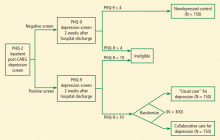The Bypassing the Blues trial: Collaborative care for post-CABG depression and implications for future research
ABSTRACTDepressive symptoms are reported by up to one-half of patients following coronary artery bypass graft (CABG) surgery, and are associated with numerous adverse outcomes, including poorer health-related quality of life, worse functional status, and delayed recovery. Strategies to detect and then manage depression in CABG patients and in cardiac populations are of great interest given the potential for depression treatment to reduce cardiovascular morbidity. Yet, many tested interventions have had little or no effect on mood symptoms in cardiac patients. “Collaborative care” is a safe and proven-effective strategy for treating depression in concert with patients’ primary care physicians; however, it had not been tested previously in patients with cardiac disease. This article presents the design and main outcome findings from the National Institutes of Health–funded Bypassing the Blues study, the first trial to examine the impact of a collaborative care strategy for treating depression among patients with cardiac disease, and our efforts to improve upon and expand the model for testing in other cardiac conditions.
Coronary artery bypass graft (CABG) surgery is one of the most common and costly medical procedures performed in the United States.1 However, up to one-half of post-CABG patients report significant increases in mood symptoms following surgery,2 and these individuals are more likely to report poorer health-related quality of life (HRQoL) and worse functional status,3 and to experience higher risk of rehospitalizations4 and death5 despite a satisfactory surgical result.
Strategies to detect and then manage depression in CABG patients and in cardiac populations are of great interest given the potential for depression treatment to reduce cardiovascular morbidity.
In recognition of the prevalence and excess burdens associated with this condition, a recent American Heart Association (AHA) Science Advisory has advocated regular screening and treatment of cardiac patients for depression.6 Yet, the Advisory has been controversial,7,8 as most depression treatment trials conducted in patients with cardiac disease have had less-than- anticipated impact on mood symptoms,7,9–14 cardiovascular morbidity,7,9,10,14 or mortality.7,9–11,13–15 Possible explanations include: (1) dependence solely on single antidepressant agents9,14 that, in general, are often ineffective,16 untolerated, or otherwise discontinued by patients17; (2) reliance on psychologic counseling in elderly, medically ill populations who may be either unwilling or unable to adhere to successive face-to-face encounters with a therapist10,13; (3) inadequate consideration of patients’ preferences for type and location of treatment18,19; (4) insufficient treatment adherence20,21; (5) perceived stigma of depression22; (6) brief duration of treatment and followup9,13,14; and (7) higher-than-expected spontaneous remission rates for depression.10,14
Over the past 15 years, numerous trials have supported use of the flexible real-world collaborative care approach to improve outcomes for depression27,28 as well as a variety of other chronic medical conditions29–32 and at a lower total cost of care.33,34 This strategy is supported even outside the framework of a trial.35,36 Moreover, collaborative care was the clinical framework37 for a Robert Wood Johnson Foundation program to realign clinical and financial incentives for providing sustainable high-quality depression treatment in primary care.38–41 It is also embraced by depression improvement initiatives supported by the MacArthur (https://www.depression-primarycare.org/)42 and Hartford (https://impact-uw.org/)43 Foundations. In recognition, a National Heart Lung and Blood Institute–sponsored working group on the assessment and treatment of depression in patients with cardiovascular disease endorsed testing of collaborative care strategies for treating depression in combination with “usual cardiologic care” as a method to improve clinical outcomes.23 Collaborative care has also emerged as an integral part of the “patient-centered medical home” model presently advocated by leading professional organizations to organize and reimburse PCPs for providing high-quality chronic illness care.44
Despite this interest in collaborative care, to date, only the “Bypassing the Blues” (BtB) trial has reported the impact of this depression treatment strategy on the clinical outcomes of a population with cardiac disease.45 In an effort to help disseminate collaborative care more broadly into routine practice as envisioned by the AHA Science Advisory, we pre sent the key design elements and main outcome findings from BtB, along with our efforts to improve upon and expand the model for testing in other cardiac conditions.
STUDY OVERVIEW








